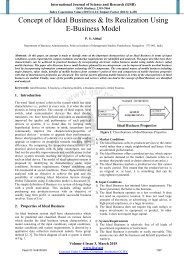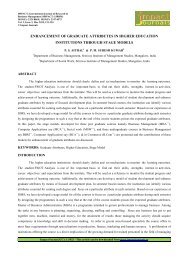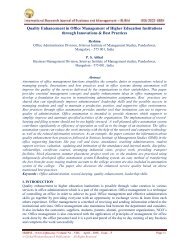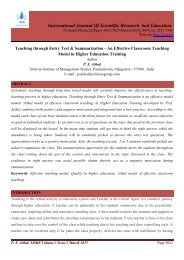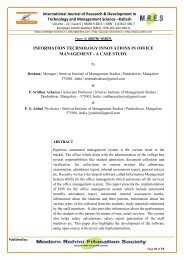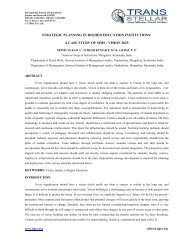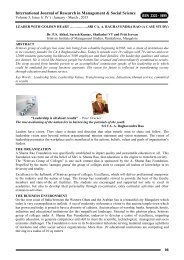How Innovations and Best Practices can Transform Higher Education Institutions : A case study of SIMS
Education has become competitive so as the educational institutions. In order to survive the competition, institutions have to improve the quality of their services. Changes in culture, aspiration and levels of skills required in securing employment for students, force higher education institutions today to rework on their educational models and add value to each and every aspect of their service. Innovations and best practices serve to enhance quality and add value. Srinivas Institute of Management Studies (SIMS), which combines technology, management and social service education has identified and implemented innovations and best practices to differentiate itself among the competitors and to add value in its educational services. In this paper, we have discussed innovations, small and big, develped indigineously and implemented during last four years. They are broadly classified under six key aspects namely "curricular aspects, teaching-learning and evaluation, research, consultancy and extension, infrastructure and learning resources, student support and progression, and governance, leadership, and management". The paper also contains some of the intitutional and individual faculty best practices having visible impact on the quality of higher education imparted by the institution. The best practices concern admission, fees, attendance, teaching, performance, skill building, employability, student involvement, collective learning, value addition, ensuring transparency, information dessimination etc. Finally two institutional best practices are elaborated with its aim of practice, underlying principles and concepts, particular contextual features or challenging issues that have had to be addressed in designing and implementing the practice, and its implementation, including its uniqueness in Indian higher education, evidence of success, identifying the problems encountered and resources required to implement the practice.
Education has become competitive so as the educational institutions. In order to survive the competition, institutions have to improve the quality of their services. Changes in culture, aspiration
and levels of skills required in securing employment for students, force higher education institutions
today to rework on their educational models and add value to each and every aspect of their service. Innovations and best practices serve to enhance quality and add value. Srinivas Institute of
Management Studies (SIMS), which combines technology, management and social service education
has identified and implemented innovations and best practices to differentiate itself among the competitors and to add value in its educational services. In this paper, we have discussed
innovations, small and big, develped indigineously and implemented during last four years. They are
broadly classified under six key aspects namely "curricular aspects, teaching-learning and evaluation, research, consultancy and extension, infrastructure and learning resources, student support and progression, and governance, leadership, and management". The paper also contains some of the
intitutional and individual faculty best practices having visible impact on the quality of higher education imparted by the institution. The best practices concern admission, fees, attendance, teaching, performance, skill building, employability, student involvement, collective learning, value
addition, ensuring transparency, information dessimination etc. Finally two institutional best practices are elaborated with its aim of practice, underlying principles and concepts, particular contextual features or challenging issues that have had to be addressed in designing and implementing the practice, and its implementation, including its uniqueness in Indian higher
education, evidence of success, identifying the problems encountered and resources required to implement the practice.
You also want an ePaper? Increase the reach of your titles
YUMPU automatically turns print PDFs into web optimized ePapers that Google loves.
International Journal <strong>of</strong> Management (IJM), ISSN 0976 – 6502(Print), ISSN 0976 - 6510(Online),<br />
Volume 6, Issue 2, February (2015), pp. 83-98 © IAEME<br />
I. INTRODUCTION<br />
Science <strong>and</strong> technology are growing steeply <strong>and</strong> consequently the knowledge base <strong>of</strong> all<br />
disciplines is fast exp<strong>and</strong>ing. The educational system is invested with the responsibility <strong>of</strong> absorbing,<br />
assimilating <strong>and</strong> delivering the new knowledge to its incumbents. <strong>Higher</strong> education therefore has<br />
become competitive. It not only matters how much in terms <strong>of</strong> quantity but how good in terms <strong>of</strong><br />
quality that it delivers the knowledge. Student centric focus is gradually shifting to student friendly<br />
approaches, <strong>and</strong> innovations <strong>and</strong> best practices are adapted to add value <strong>and</strong> get more mileage in the<br />
knowledge delivery. Changes in culture, aspiration <strong>and</strong> levels <strong>of</strong> skills required in securing<br />
employment for students <strong>and</strong> cost <strong>of</strong> providing the service, force higher education institutions today<br />
to rework on their educational models <strong>and</strong> add value at each <strong>and</strong> every aspects in their service [1-3].<br />
This has become a high priority for institutions either struggling for existence or striving for<br />
excellence.<br />
<strong>Higher</strong> education is a change-resistant enterprise. Academic culture, faculty governance <strong>and</strong><br />
an unusual bureaucracy all work together to slow down evolution. In part, this has contributed to the<br />
enormous survival success <strong>of</strong> old br<strong>and</strong>ed higher education institutions. In order to improve the<br />
quality <strong>of</strong> higher education, institutions have to think beyond presently adopted credit based systems<br />
[4-5]. By adding competency to the students <strong>and</strong> the system, through innovations <strong>and</strong> best practices,<br />
the institutions <strong>can</strong> add value to the education system to address large social <strong>and</strong> economic<br />
challenges that began about a decade ago <strong>and</strong> are in full swing now. These include rapidly rising<br />
costs <strong>of</strong> tuition, a growing need for more <strong>and</strong> repeated education for employment, global market<br />
competition challenges etc. Competency-based education provides the flexibility students need,<br />
focuses on assessing learning mastery needed to be a well-functioning, <strong>and</strong> is affordable because it is<br />
scalable in ways that create efficiencies [6-7].<br />
II.<br />
<strong>SIMS</strong> - AN OVERVIEW<br />
Srinivas Institute <strong>of</strong> Management Studies (<strong>SIMS</strong>) is established with the vision <strong>of</strong> imparting<br />
quality education <strong>and</strong> exp<strong>and</strong>ing opportunities to all the aspirants <strong>and</strong> across all realms <strong>of</strong><br />
knowledge. It envisages to become a centre <strong>of</strong> excellence to serve as change agent in the society by<br />
generating a pool <strong>of</strong> human resources trained in science <strong>and</strong> technology, management <strong>and</strong> social<br />
service. The college <strong>of</strong>fers bachelor <strong>and</strong> master degree programmes in Business Management <strong>and</strong><br />
Computer Science <strong>and</strong> Bachelor degree in Commerce <strong>and</strong> Masters Degree in Social Work. The<br />
vision <strong>and</strong> mission <strong>of</strong> the institute are well publicized though its website, calendar, prospectus etc.<br />
The curriculum provided for these courses are effectively improved by resorting to action planning<br />
through developing academic calendar, teaching plan, teachers diary <strong>and</strong> <strong>study</strong> material. In addition<br />
to the specialization required to be taught, the institute <strong>of</strong>fers dual specialization facility <strong>of</strong> its own,<br />
<strong>and</strong> equip students to wider opportunities for employment <strong>and</strong> research. A large number <strong>of</strong><br />
certificate programmes <strong>of</strong> short duration, customized to suit the students <strong>of</strong> all courses, are <strong>of</strong>fered to<br />
promote skill development to enhance employability. Entrepreneurial talents are cultivated among<br />
the students by EDP cell. The institute <strong>of</strong>fers orientation programmes, guest lectures, <strong>study</strong> tours,<br />
video lectures, field practicums, NGO internship, industrial exposures, student exchange<br />
programmes <strong>and</strong> international educational visits also as supplements to the curriculum. It supports<br />
research based learning, exposure based learning, experiential learning, event management learning,<br />
field work based learning <strong>and</strong> laboratory based learning. Value addition is incorporated in teaching<br />
through adding extra sessions over <strong>and</strong> above the prescribed syllabus for insight development. Weak<br />
students <strong>and</strong> slow learners are supported through tutorials, counselling <strong>and</strong> mentoring.<br />
84




